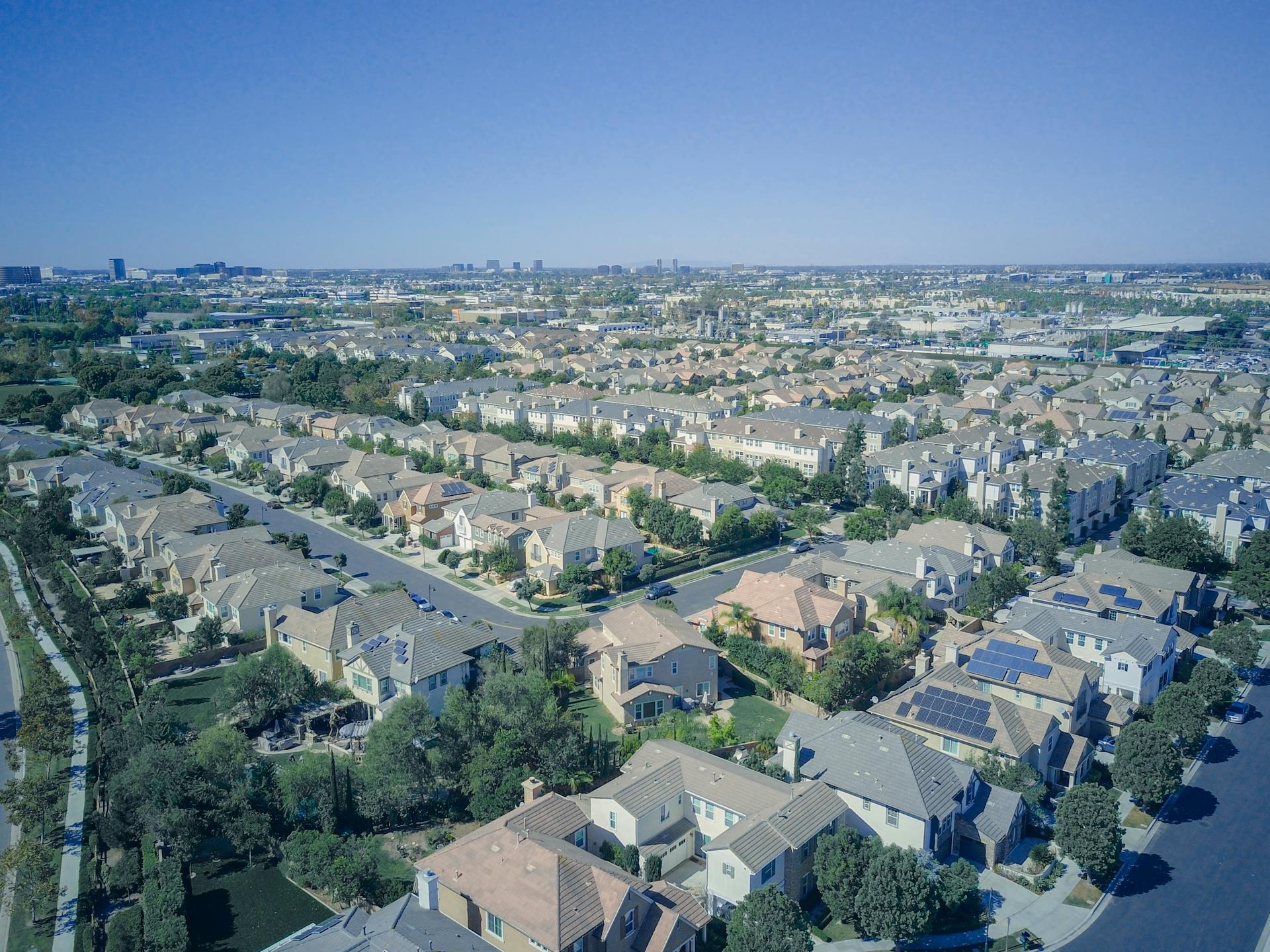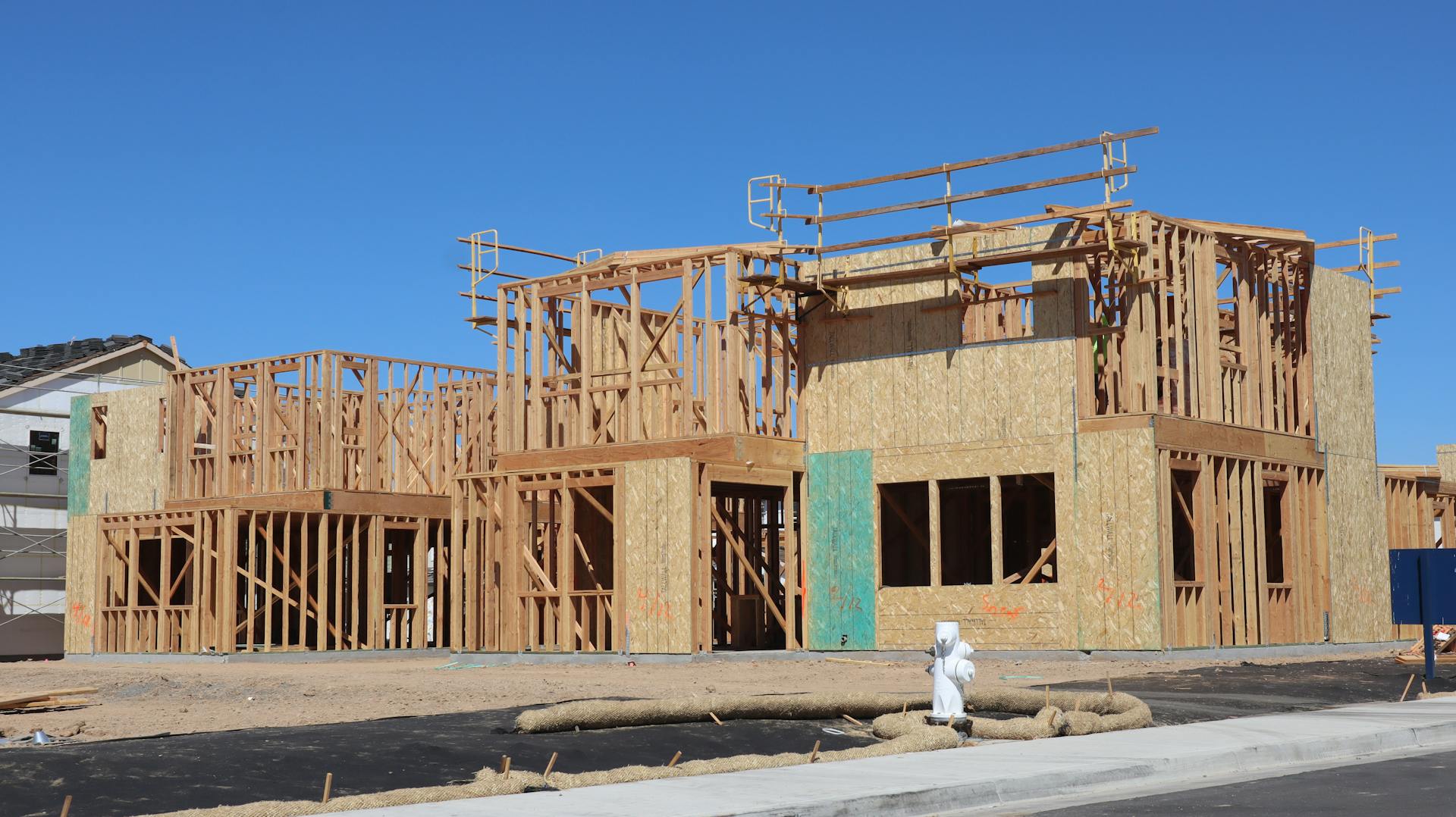
The California condo insurance crisis is a pressing issue that affects thousands of homeowners in the state. The crisis is largely due to the increasing cost of insurance claims, which have skyrocketed in recent years.
In 2020, the Insurance Information Institute reported that the average cost of a condo insurance claim in California was $124,000, a 40% increase from the previous year.
Many condo associations are struggling to pay for these claims, leaving them with no choice but to raise monthly fees or special assessments on owners. This has led to a significant financial burden on condo owners, who are already facing high costs for living in California.
The crisis is also causing a shortage of condo insurance options for homeowners, making it difficult for them to find affordable coverage.
A fresh viewpoint: Types of Homeowner Insurance
California Condo Insurance Crisis
California is not the only state feeling the pinch of climate-related insurance losses. Insurers are bleeding cash from climate shocks around the country, leading to higher rates and sometimes cancellation notices.
This crisis is affecting homeowners across the US, not just in California and Florida. It's a nationwide issue that's causing financial strain for many.
The consequences of this crisis are clear: higher insurance rates and potentially even cancellation notices for homeowners.
For more insights, see: Homeowners Insurance Cover Water Damage
Regulatory Challenges
California's insurance regulatory system has made it impossible for insurers to accurately project potential losses and adjust their premiums accordingly. This has led to tens of thousands of policies being canceled or not renewed.
Consumer groups have voiced sharp criticism of the regulatory response, arguing that the reforms may lead to steep price hikes without ensuring broader availability of coverage. Consumer Watchdog has called for mandatory requirements for insurers to serve customers proactively, especially those taking measures to make their properties fire-resistant.
Insurance Commissioner Ricardo Lara has introduced a series of reforms aimed at stabilizing the market, including granting insurers the ability to use advanced computer models to assess future risks, especially as they pertain to climate change. By doing so, Lara hopes to incentivize companies to maintain their presence in the state.
Insurers must also expand coverage proportionally in wildfire-prone areas to gain rate hike approvals under these reforms. However, some insurers like Liberty Mutual have shown signs of returning, while others have not.
Lara's proposed regulatory changes would likely make insurance coverage more expensive in fire-prone regions. However, there are no free lunches, and it's better to have costlier coverage than none.
Intriguing read: What Is Not Covered by an Umbrella Policy
Industry Background
California has a unique real estate market, with a high concentration of condominiums, particularly in coastal areas like San Francisco and Los Angeles.
The state's housing market is largely driven by demand from tech industry workers, who are willing to pay a premium for housing in desirable neighborhoods.
Condo insurance is a vital aspect of condo ownership in California, as it protects owners from financial losses due to damage or destruction of their unit.
A unique perspective: Housing Loan Protection Insurance
Company Background
California's property insurance market is facing a crisis, and several insurers are scaling back operations in the state.
Liberty Mutual, one of the affected companies, has stopped offering new condo and renters' policies under its parent brand since late 2023.
The company has also clarified it will not resume writing homeowners policies, a decision that reflects a broader industry trend.
State Farm and Allstate have also scaled back operations in California for similar reasons, such as rising construction costs and unprecedented wildfire risks.
A mix of increasing risks, regulatory hurdles, and high costs has forced providers to reassess their strategies.
Worth a look: Insurance Back Office Services
Introduction

California's insurance crisis is a pressing issue, with almost daily news stories about insurers refusing to write new policies or canceling current ones. This crisis is largely due to the state's misguided approach to environmentalism and market interventions.
The severe California wildfires over the last decade have subjected insurance providers to extreme losses, with losses more than tripling to over $15 billion in 2017 from slightly more than $4 billion in 2016. In 2018, losses remained high at $13 billion.
Premiums are not arbitrary prices, but rather driven by anticipated claim expenses faced by insurers, which depend on the frequency of claims, the severity of damage, and the cost of repairs. This means that insurers are simply passing on the costs of these catastrophic events to policyholders.
Before 2017, California insurers never incurred losses greater than $5 billion.
A fresh viewpoint: What Are the Best Places to Elope in California?
Impact on Policyholders
Thousands of California condo owners and renters will need to find new insurance providers as major insurers like Liberty Mutual and Safeco cancel existing policies.
Existing policies for renters and condos won't expire until at least 2026, giving them a temporary reprieve.
A less competitive market could lead to rising premiums across the state, making it harder for policyholders to afford insurance.
For many homeowners in high-risk zones like the Santa Cruz Mountains or Northern Wine Country, government-mandated FAIR Plans have become a default option, but these plans are frequently expensive and limited in their offerings.
Policyholders fear that insurers reducing their presence will result in skyrocketing costs as fewer companies compete to provide affordable options.
A unique perspective: Delta Dental Insurance Seniors
Regulatory Response
California's insurance regulator, Ricardo Lara, has acknowledged the state's home insurance crisis, calling it an "insurance crisis" that affects over 30 million people. He's in a tough spot, trying to solve it.
Insurance Commissioner Ricardo Lara has introduced reforms to stabilize the market, including allowing insurers to use advanced computer models to assess future risks, especially those related to climate change. This is supposed to incentivize companies to stay in the state.
Under these reforms, insurers must expand coverage in wildfire-prone areas to gain rate hike approvals. Some insurers, like Farmers Insurance, have shown signs of returning, but Liberty Mutual's decision is a mixed result.
Critics argue that the reforms don't provide enough consumer protection, and that they might lead to steep price hikes without ensuring broader availability of coverage. Consumer groups have voiced sharp criticism, calling for mandatory requirements for insurers to serve customers proactively.
California's construction sector is highly regulated, which raises replacement costs and contributes to the crisis. The state's expansive welfare and relief policies may also discourage labor participation, exacerbating labor shortages.
Market Analysis
The California condo insurance crisis is a complex issue, but let's break it down. Insurers are withdrawing from the market, leaving many condos without coverage. This is partly due to a surge in claims from wildfires and other disasters.
In 2020, there were over 9,500 wildfires in California, causing $12.2 billion in damages. This has led to a significant increase in insurance claims, straining the insurance industry's resources. As a result, many insurers are now hesitant to provide coverage to condos in high-risk areas.
The lack of insurance options is forcing condo owners to seek alternative coverage, which can be costly and unreliable. In some cases, owners are being forced to pay thousands of dollars more for coverage or even going without insurance altogether.
A different take: Can You Get Dental Insurance without Health Insurance
Home Rates in America Are Distorted
Home rates in America are wildly distorted, and it's not just because of climate change. Climate change is driving rates higher, but not always in areas with the greatest risk.
Insurance companies can't continue to write policies if they're not profitable. Commissioner Lara noted that insurance companies aren't like utility companies, and they don't have to be in California if they're not profitable.
The state's over-regulating approach is driving insurers away. California must move away from an over-regulating, command economy model to a free-market approach in which premiums track with risk.
Florida and Louisiana face similar crises due to regulatory burdens. Their catastrophes are hurricanes, floods, and wind-related damage to below-sea-level development.
Expand your knowledge: Can I Change My Insurance Agent
Market Causes
The California homeowner insurance market has been hit hard by the increasing cost of paying policyholder damages due to wildfires. This has led to insurer losses growing exponentially more expensive.
Over the last decade, the number of forest acres destroyed by wildfires in California has been staggering - 10 million acres since 2017. This is a massive increase in destruction.

Wildfires in California have become more destructive and intense, with eight of the 10 largest recorded wildfires occurring since 2017. This trend is alarming.
The sheer scale of the destruction is evident in the number of homes lost - 39,000 since 2017. This is a devastating blow to families and communities.
Four of the six largest wildfires in California's history have occurred in 2020 alone, a year that will be remembered for its record-breaking destruction.
Compare Home Costs in Our Interactive Map
Insurance premiums are surging unevenly across the country, which means your rates might be out of step with the actual risks in your area.
To get a sense of how your home insurance costs compare, check out our interactive map. It's a great tool to see how insurance premiums vary from one region to another.
Insurance companies are adjusting their rates based on local factors such as crime rates, weather patterns, and property values, which can lead to significant differences in premiums.
Consider reading: Health Insurance Broker Commission Rates
For example, you might find that your neighbor's home insurance premium is much higher or lower than yours, depending on the specific location and conditions of their property.
By using our interactive map, you can quickly and easily compare your home insurance costs to those in other areas and get a better understanding of what's driving the differences.
A fresh viewpoint: Home Damage Claims
Frequently Asked Questions
Why are home insurance companies pulling out of California?
Home insurance companies are pulling out of California due to rising construction costs, growing wildfire risk, and a challenging reinsurance market. This perfect storm of factors is making it difficult for insurers to offer affordable coverage in the state.
Why did my homeowners insurance go up in 2024 in California?
Your California homeowners insurance premium increase in 2024 may be due to regional risk factors such as wildfires, earthquakes, and other natural disasters that have led to changes in the risk assessment for your area
Sources
- https://www.nytimes.com/interactive/2024/12/18/climate/insurance-non-renewal-climate-crisis.html
- https://calmatters.org/commentary/2024/08/california-home-insurance-crisis-commissioner/
- https://www.nbcbayarea.com/investigations/consumer/when-will-cas-home-insurance-crisis-end/3683216/
- https://www.liveinsurancenews.com/liberty-mutual-drops-california/8560790/
- https://americafirstpolicy.com/issues/californias-homeowner-insurance-market-freefall-regulatory-folly-run-amok
Featured Images: pexels.com


